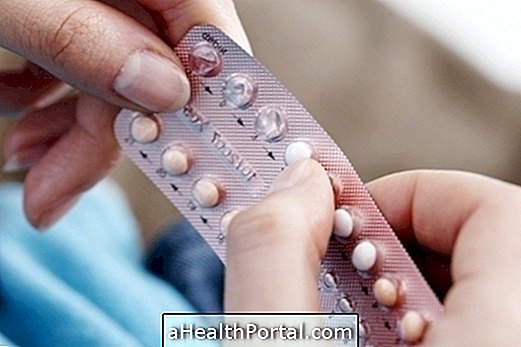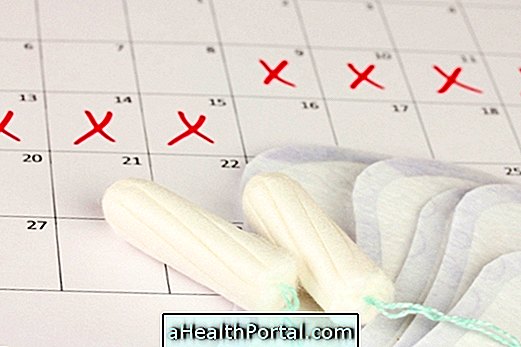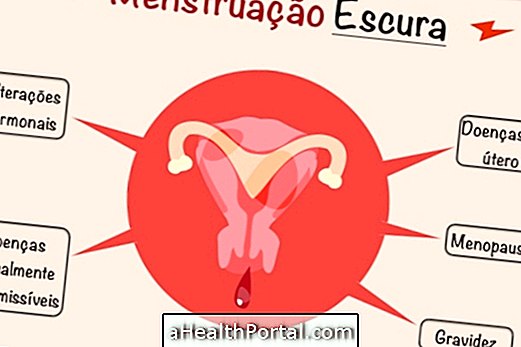There are several contraceptive methods that help prevent unwanted pregnancies, such as the contraceptive pill or the arm implant, but only the condom prevents pregnancy and protects against sexually transmitted diseases at the same time and should therefore be used in all relationships, especially when the partner is not known.
Before choosing and using a contraceptive method it is important to consult the gynecologist to decide the most appropriate option, and the best method is always the most appropriate to the conditions of women and men, such as age, cigarette use, illness or allergies, for example.
1. Contraceptive pill

The oral contraceptive, also known as contraceptive pill, is the method most used by women to avoid pregnancy, because it has hormones that are similar to those produced by the ovaries, causing the ovulation does not occur and there is an egg ready to be fertilized.
The types of oral contraceptives available are the combined pill, which contains estrogen and progestogen, and the progestin-only minipill, which is more common during breastfeeding, in women who smoke or those over 35 years of age.
The contraceptive pill can be purchased for free at a health post, but it depends on the brand of the contraceptive because some have to be bought at the pharmacy. The most common brands of contraceptive pills are Selene, Yasmin, Cycle 21 and Diane 35. In addition, there are other brands like Yaz, Minima, Microvlar or Cerazette, for example.
- Advantages : In addition to helping prevent pregnancy, it can also be used to decrease PMS symptoms, reduce menstrual flow and pain during menstruation, regulate the menstrual cycle, improve acne and excess hair, and help prevent pregnancy. pelvic inflammatory disease, cysts or ovarian cancer;
- Disadvantages : Although it is a very effective and safe method, the woman must be responsible and take a tablet every day at the same time, without forgetting, to avoid pregnancy;
- Possible Side Effects : The most common include nausea, breast pain, short blood loss outside of menstruation, decreased blood flow and symptoms of depression.
How to take the contraceptive pill correctly
In most cases you must take 1 tablet a day, always at the same time, for 21 days until the end of the carton and when you finish taking a 7 day break, which is when the menstruation should come down and on the 8th day, start a new card If this is your contraceptive method read all about the birth control pill.
2. Contraceptive implant

The contraceptive implant, such as Implanon or Organon, is a method that helps prevent pregnancy through a small plastic tube that is introduced into the inside of the arm, under the skin, by the gynecologist and which releases hormones into the blood form slow, preventing ovulation and making it difficult for sperm to enter the woman's uterus.
This device can stay in the woman's arm for up to 3 years, but can only be placed and taken by the gynecologist and after removing the fertility returns to normal after 1 month.
- Advantages : in addition to avoiding pregnancy can be used to decrease abdominal pain caused by menstruation. In addition, the implant does not interfere with intimate contact or breastfeeding, and is an excellent method for women who frequently forget to take the tablet, have mental illness, or have gastrointestinal problems.
- Disadvantages : It is a more expensive and accurate method of a health professional to be placed under the skin.
- Possible side effects : It can cause irregular blood loss, appearance of skin blemishes, nausea, headache and mood swings.
When and how to place the implant
The implant needs to be placed in the hospital by the gynecologist until the first 7 days of the menstrual cycle, or at any point in the cycle if it is certain that the woman is not pregnant. To place and remove the implant it is necessary to perform a small surgery with local anesthesia that is applied to the arm, being normal in the first 3 days after the intervention to have pain or to have a small purple spot.
Learn more about the implant to avoid unwanted pregnancy.
3. Intrauterine device (IUD)

The intrauterine device, known as an IUD, is a T-shaped plastic contraceptive method that is introduced into the uterus by the gynecologist and can remain for about 5 years while remaining effective.
This contraceptive technique is very effective and does not cause discomfort, preventing pregnancy by copper action or release of hormones that make it difficult to fertilize.
- Advantages : It is a method that does not interfere with the sexual act and is a good method for those who forget to take the tablet every day and at the same time, as it can remain in the uterus for several years.
- Disadvantages : need to be put by a health professional and in some cases can lead to the onset of anemia.
- Possible Side Effects : It can cause pain for a few days after placement, lead to minor blood loss in the following months and may further increase the risk of vaginal infections.
See how the IUD prevents pregnancy.
4. Men's and women's sweaters

Condoms are an excellent contraceptive method to prevent pregnancy, as well as being the only method that protects against the spread of sexually transmitted diseases such as AIDS or syphilis.
However, to be effective it is necessary to place the condom correctly before each intimate contact, preventing direct contact between the penis and the vagina, preventing sperm from reaching the uterus. Here are the top 5 mistakes when it comes to putting on a condom.
- Advantages : They are usually cheap, easy to put on, do not cause any kind of change in the body and protect against sexually transmitted diseases.
- Disadvantages : Some people may have an allergy to the condom material, which is usually latex. In addition, the condom can cause discomfort in some couples or tear during intimate contact, increasing the chances of getting pregnant.
- Possible side effects : in addition to the risk of allergy to the type of condom material, there are no side effects to the use of condoms.
5. Vaginal diaphragm

The diaphragm is a ring-shaped contraceptive method that prevents sperm from entering the uterus, preventing fertilization of the egg. The diaphragm can be used several times for about 2 years and therefore, after use should be washed and stored in a clean place.
- Advantages : does not interfere with intimate contact and can be inserted up to 24 hours before the relationship. In addition, it still reduces the risk of pelvic inflammatory disease.
- Disadvantages : It needs to be placed up to 30 minutes before intimate contact and taken 12 hours after intercourse, and should be repeated every time you have intimate contact, otherwise it is not effective.
- Possible side effects : There are no side effects associated with using the vaginal diaphragm.
Understand better what the diaphragm is and how to put it.
6. Vaginal ring

The ring is a rubber device that is introduced into the vagina by the woman and its placement is similar to the introduction of an inner absorbent. The woman should remain with the ring for 3 weeks and then should withdraw and take a 7 day break for menses to come down, putting a new ring back on.
- Advantages : It is easy to use, does not interfere with intimate contact, is a reversible method and does not alter the vaginal flora.
- Disadvantages : Does not protect against STDs, can lead to weight gain and can not be used in a number of cases, such as liver problems or high blood pressure.
- Possible Side Effects : In some women it can cause abdominal pain, nausea, decreased libido, painful menstrual periods and increase the risk of vaginal infections.
See more about vaginal ring, how to put and possible side effects.
7. Injectable contraceptive

Contraceptive injection, such as Depo-Provera, should be given to the arm or leg muscle once a month or every 3 months by a nurse at the health clinic.
The injection slowly releases hormones that prevent ovulation, but its prolonged use can cause delayed fertility, increased appetite, which can lead to weight gain, in addition to headaches, acne and hair loss, for example. It is a great method for women with mental illness, with tuberculosis or epilepsy who can not take birth control pills or have many vaginal infections and can not wear a ring or diu.
8. Ligation and Vasectomy
Surgery is a definitive contraceptive method, preventing the woman or man from having children for the rest of their lives, so in most cases this method is only used after deciding not to have more children, being more frequent in women or men with more than 40 years.
In the case of the woman, tubal ligation is performed with general anesthesia, where a cut or a tourniquet is made in the tubes, which are closed, preventing the sperm from meeting the ovum. The definitive sterilization of the woman requires hospitalization for about 2 days and usually the recovery takes about 2 weeks.
A vasectomy is the surgery performed on the man, with general anesthesia that takes about 20 minutes, being made a cut in the channel through which the sperm from the testicles to the seminal vesicles pass, but the man although it stops being fertile, continues ejaculating and does not develops impotence.

9. Natural Methods
There are other methods that may also help prevent pregnancy, but should not be used individually because they are not fully effective and pregnancy may occur. Thus, some methods can be:
- Calendar Method: This method requires knowing how to calculate the fertile period by subtracting from 11 days to the longest cycle and from 18 days to the shortest cycle. Learn how to calculate in
- Temperature Method: body temperature is higher after ovulation and to know the time of the month that the woman is more fertile should measure the temperature with a thermometer always in the same place;
- Mucus method: During the most fertile period the woman has thicker mucus, similar to egg white, which indicates that the chances of getting pregnant are greater.
- Method of Interrupted Coitus: This method involves withdrawing the penis from the inside of the vagina the moment the man is going to ejaculate. However it is not safe and is advised against. Understand why by clicking here.
According to these methods it is necessary to avoid intimate contact during the fertile period, which is when the woman is more likely to become pregnant and to understand the profile of the woman, it usually takes 3 to 6 cycles.
Here's how to calculate your fertile time and avoid getting pregnant:




















